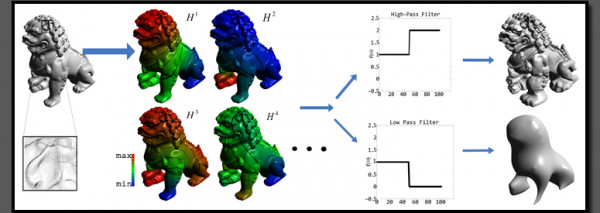NSF CAREER Award

MINTS affiliate Dr. Guo has just been awarded an NSF CAREER Award.
With the popularity of real-time 3D/4D data capturing capabilities, there is an emerging need to compute the arbitrary 3D models and their dynamic deformation over the networks. Traditional model-driven deformable models have their bottlenecks since the spatial information for large-scale datasets cannot be efficiently solved and adaptively minimized over different network conditions. This NSF CAREER project centers on the concept of spectrum-driven deformable models. Analogous to Fourier analysis being applied to image processing, the spectral deformable models employ manifold harmonics to efficiently and effectively perform segmentation, registration, modeling, compression, and streaming of 3D deformable surfaces and volumes.
In Mark Kac’s article of 1966, he asked the question “Can one hear the shape of a drum?” It was understood that the shape of the drumhead determines the set of harmonic bases and their corresponding frequencies at which the drumhead can vibrate. If we know the shape, we can determine the frequencies via the Helmholtz equation – computing the eigenvalues and eigenfunctions of the Laplacian of the shape. If the drum is of arbitrary 3D shape, the technical challenge resides on computing the generalized eigen-problem of Laplace-Beltrami Operator defined on such 3D shapes.
With this NSF CAREER Award, the computer scientist Dr. Xiaohu Guo will investigate the theoretical foundations behind this magic spectral transformation on shapes of arbitrary 3D models. Note that Dr. Guo has started the investigation of such spectral transformation on point-sampled 3D surfaces, called “Point-Based Manifold Harmonics” (http://www.utdallas.edu/~xguo/pbmh.htm). The further theoretical investigation on transforming rotation and tensor fields on arbitrary 3D models will be studied. Dr. Guo will apply such manifold harmonics to solve the problems of 3D shape segmentation, registration, modeling, compression, and streaming over computer networks. With such spectral framework, the real-time scanned, dynamic 3D models can be treated in the same way as applying Fourier transform to 2D images and videos.
The theoretical and technical breakthrough can benefit our society at large, from tele-diagnosis to remote sensing, through Dr. Guo’s further outreach activities.


















